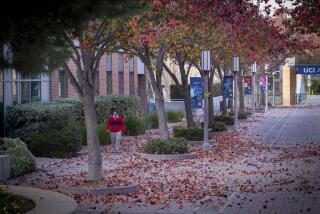An affordable UC for the middle class
It’s no wonder the University of California regents delayed serious consideration of a plan that calls for annual tuition to rise as high as $22,000 within five years if the state does not increase the university’s budget. Such a steep increase, from about $12,000 this year, would do more than strain the wallets of families across California. It would change the nature of the university in profound ways.
UC would still be cheaper than most private universities, but the price difference would not be so striking — it would cost about two-thirds as much instead of one-third. Take into account that room and board costs at UC are no cheaper than at private schools, and the magnet drawing the state’s brightest students to the public university loses some of its power. With larger financial aid packages more easily available to high-achieving students at private colleges, the cost difference narrows even further.
Of special concern is the effect on the middle class, which already is a shrinking demographic on UC campuses, while the numbers of poor and affluent students have grown, according to a university report issued this year. From 1999 to 2009, the number of disadvantaged undergraduate students, with family incomes of $50,000 or less, rose by 61%; the number of affluent students, with family incomes of more than $149,000, shot up by 73%. By comparison, the number of students in between rose by 15%, and only 5% among those in the higher end of that range.
Put another way, half of the university’s undergraduates in 1999 were middle class, as indicated by the report. By 2009, that figure was 41%.
Is this because middle-class families, who generally don’t qualify for financial aid, now see UC as beyond their reach after several years of price hikes? Are they finding a better deal at private colleges? Or is it that the middle class simply makes up a smaller proportion of California as a whole? The university is planning to find out more over the next few years.
There are few good solutions available to university leaders during such tight financial times. Although UC President Mark Yudof presented the tuition increases to the regents as a plan, it’s actually more of a wake-up call to the realities faced by the university if more resources aren’t forthcoming from the state. But that also means university leaders should be looking right now for opportunities to make prudent cuts that will rein in future price increases.
And when the regents consider a long-term package of tuition increases, they should simultaneously look at reformulating their financial aid policies to provide greater assistance for middle-class families. UC covers the full cost of tuition for students whose families earn $80,000 or less; there’s still financial aid for families with higher incomes, but not nearly as much.
Stiff increases in tuition, if they prove necessary, should be accompanied by a more graduated financial aid formula that spreads available money among more students. A family earning $75,000 can’t afford the full tuition and fees for UC, but it can afford something; students can still work and take out loans. That would leave some money — a smaller amount, presumably — available for a family earning, say, $85,000 or $90,000 or $100,000.
The university also should consider a temporary policy that favors admission to students in the immediate geographical area for a certain percentage of new undergraduates. That way, more students could live at home and avoid the hefty cost of a dorm. UC campuses are not usually commuter schools, but troubled times call for a willingness to make sensible changes. The university also should not rule out variable pricing depending on the campus. It’s not likely that many undergraduates would be willing to pay $22,000 in tuition alone to attend the less popular campuses at Merced and Riverside.
The rising numbers of low-income students, who in 2009 made up 34% of enrollment, are a heartening sign that disadvantaged students are more likely to get the best higher education this state can offer. But the University of California, which was created to provide an affordable top-flight education to the highest-achieving students in the state, also should be financially accessible to middle-class families. That’s fairer to students, whose ability to attend should be based on achievement rather than income, and better for the university.
More to Read
A cure for the common opinion
Get thought-provoking perspectives with our weekly newsletter.
You may occasionally receive promotional content from the Los Angeles Times.










